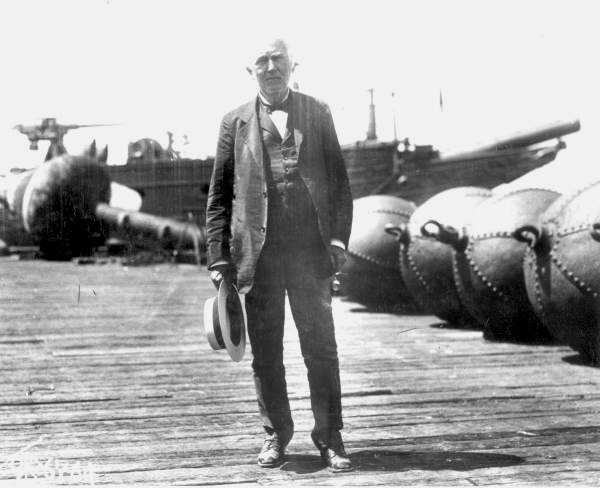
Thomas Alva Edison (1847-1931) was an inventor and businessman. Edison is well known for developing many devices such as the phonograph, the long-lasting light bulb, and the motion picture camera. During the Great War, Edison was interviewed by the New York Times about his thoughts on the War. He called for preparedness in case America was dragged into the war in Europe. After the interview was published, Edison was personally called upon by the Secretary of the Navy, Josephus Daniels, to serve as the head of the newly created Naval Consulting Board (NCB) in 1915. This committee would be of American businessmen and inventors from all engineering branches of study, as well as educated volunteers and machinists, to help America with the upcoming war effort. The NCB would not only look over ideas submitted to the military, but it’s members conducted its own experiments and implemented ideas. It should be noted that although it was the NCB, the department of Army also requested aid for ideas and experiments.
Edison already a veteran of helping the Navy during the Spanish-American War, dropped his research and experiments to aid his country. As the chairman of the NCB and one who took pride in hands on work, Edison worked from 1917-1919 in Key West, FL, Washington D.C., West Orange, NJ, and overseas on the USS Sachem, a Naval ship used to help conduct sea experiments. During his two years serving the United States military, Edison developed and created over 49 ideas, prototypes, and devices to advance current technology such as airplanes, ships, submarines, and weapons; as well as to help aid American military personal. Here are some of the ideas and experiments that Edison worked on during his time with the NCB. After the sinking of the RMS Lusitania by unrestricted submarine warfare by German U-boats, the biggest problem became that of detecting and avoiding submarines for US ships. Edison developed a device of detecting submarine by sounds from a moving vessel, it would be able to hear a torpedo from up to 5,000 yards away. With connection of detecting a torpedo, Edison developed an idea for quick turning ships using sea anchors to quickly turn the ship 90 degrees, it worked well with small ships, but large ships tended to come to a complete stop. Another idea, more strategic, was to only send out ships at night to reduce their visibility, as well as smudging sky lines or smokescreens, zig-zag maneuvers, and camouflaging ships. Other ideas including a strategy for navigating ships out of mined harbors by enemy mine layers using friendly subs to help ships navigate and avoid the moines. A steel net was developed with junction of detecting incoming torpedoes, which would be released to slow the torpedo down enough to miss the ship. An underwear searchlight was developed to help destroyers track and find U-boats, as well as an oleum cloud shell which would be fired at the U-boat to obstruct its visibility letting merchant ships escapes and destroyers to close in for a kill.
To aid destroyers, Edison devised a water-penetrating projectile that would not ricochet off the water and continue smoothly through the water to reach U-boats. When it came to our Naval submarines, Edison brought forth ideas about submarine stabilization, hydrogen detectors that would alert of explosions by enemy torpedoes, as well as a gas mask to protect sailors who were at observing posts to keep watch for U-boats but were constantly breathing in warship fumes. When it came to warships, Edison proposed ideas to extinguish coal fires safely from within the ship, as well as a telephone system for ships that could contact other ships. A direction finder for incoming enemy airplanes. Sound ranging device that would predict the direction and distance of enemy guns. For the department of the Army, Edison was asked to create an artillery shell that would burst in midair to cause more damage to enemy troops or positions. These are just some of the significant ideas and experiments that Edison worked on while he did his patriotic duty to his country as chairmen of the Naval Consulting Board.
Sources:
Alvarado, Rudolph Valier V. The Life and Work of Thomas Edison. (New York City: Alpha Books, 2001).
“Detailed Biography – the Edison Papers.” Accessed December 3, 2016. http://edison.rutgers.edu/bio-long.htm.
Daniels, Josephus, letter to Thomas A. Edison, July 7, 1915. Rutgers: The Thomas Edison Papers, (MF01; TAEM 278:7).
Marshall, Edward. “Edison’s Plan for Preparedness: The Inventor Tells How We Could Be made Invincible in War Without Overburdening Ourselves with Taxation.” New York Times, May 30, 1915. ProQuest Historical Newspapers (97783472).
Meadowcroft, William Henry. Lists and Inventories of Thomas Alva Edison. Supplied 1919. Retrieved from Rutgers: The Thomas Edison Paper, (X128C00B; TAEM 0:0).
Miles, Paul L. The United States in the First World War: An Encyclopedia. Edited by Anne Cipriano Venzon. New York: Garland Publishing, 1999.
“President Favors Amble Defense: Whole Nation Convinced We Should Be Properly Prepared, He Tells Inventions Board.” New York Times, October 7, 1915. ProQuest Historical Newspapers (97715293).
Scott, Lloyd. Naval Consulting Board of the United States. (Washington, D.C., Washington Government Printing Office, 1920).
Image Credit: Thomas A. Edison at Key West navy base during World War I. Between 1914 and 1918. Black & white photoprint, 8 x 10 in. State Archives of Florida, Florida Memory. <https://www.floridamemory.com/items/show/28559>, accessed 11 January 2017.